Read more about the shrubs that you will encounter here at Suncadia!
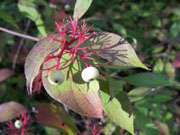
Red Osier Dogwood–Cornus Stolonifera is a species of dogwood native throughout northern and western North America from Alaska east to Newfoundland, south to Durango and Nuevo León in the west, and Illinois and Virginia in the east. In the wild, it commonly grows in areas of damp soil, such as wetlands.
It is a medium to tall deciduous shrub, growing 1.5-4 m tall and 3-5 m wide, spreading readily by underground stolons to form dense thickets. The branches and twigs are dark red, although wild plants may lack this coloration in shaded areas. The leaves are opposite, 5-12 cm long and 2.5-6 cm broad, with an ovate to oblong shape and an entire margin; they are dark green above and glaucous below; fall color is commonly bright red to purple. The flowers are small (5-10 mm diameter), dull white in color, in clusters 3-6 cm diameter. The fruit is a globose white berry 5-9 mm diameter.
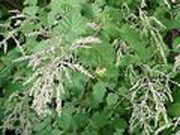
Ocean Spray-Holodiscue discolor
Ocean Spray is an attractive shrub with many erect or spreading stems and numerous sprays of pendant flowers. It is well suited for use in the woodland garden. The stems arise 1-3 meters in height, and the branches are slender, angled, and often arching. The bark is a deep grayish-red. The leaves alternate on the stems. The petioles are 10-15 mm long and the blades are 3-10 cm long. The blades are ovate to ovate-lanceolate with a rounded base and 15-25 shallow lobes which are coarsely toothed.
The numerous flowers are found in diffuse, many-branched panicles from 10-17 cm long. The flowers are each about 5 mm wide, the petals barely exceeding the sepals. The petals are white or cream-colored.
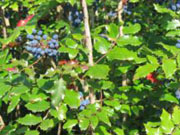
Oregon Grape, Shinning-Mahonia aquifolium
Oregon Grape is an evergreen shrub, not related to the deciduous vine that its original plant called “grape.” But its fruit clusters indeed resemble those of small Concord grapes. Other names are: holly grape, shining Oregon-grape, Oregon grape holly, Washington holly, ash barberry, and holly-leaved mahonia.
The leaves consist of 5 to 9 (13) thin leaflets, variably spiny and glossy, sometimes turning purplish in winter. From February into May, find plump 3 inch high clusters of sweetly scented bright yellow flowers. Some people liken the scent to that of Lily of the Valley, others to honey. The first deep blue, juicy, sour berries ripen in late June; many are available thereafter. Mammals and some birds eat the berries, so seedlings occur often under bird perches. The berries yield a sour purple juice valuable for making jelly, nutritious popsicles, or whatever else a creative cook can dream up.
Though edible (like Low Oregon-grape), Tall Oregon-grape flowers, tender young leaves, and berries are inferior in flavor, which is tainted with bitterness. Wildcrafters dig the roots, dry them and sell them to medicinal herb vendors. The primary active constituent is the alkaloid berberine, potentially poisonous in great quantity but valuable in proper doses. Oregon grape is used as a bitter tonic (it is related to the herb goldenseal) and has proved useful for treating skin problems, syphilis, dysentery and the like. Oregon grape also has been used to make a strong yellow dye. And its foliage is used in floristry.
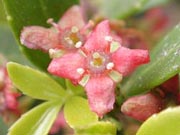
Oregon Boxwood (Myrtle)- Oachistima myrsnites
The Oregon boxwood is an attractive evergreen shrub with numerous quadrangular stems from 20-100 cm tall. The leathery leaves are oblong-lanceolate in shape with short petioles and toothed margins. The upper surface of the 1-3 cm leaves is a dark glossy green while the lower surface is paler.
The 1-3 flowers are small, 4-parted on short peduncles. The petals are reddish-brown or maroon to dark yellow in color. The flowers are solitary or clustered in the leaf axils. The stamens are inserted at the edge of a flattened disc. The ovary is 2-celled with 1 stigma. The fruit is a one- or two-seeded capsule from 3-5 mm long with shiny black or dark brown seeds.
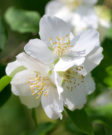
Mock Orange –Philadelphus lewisii is a genus of about 60 species of shrubs from 1 to 6 m tall, native to North America, Central America, Asia and (locally) in southeast Europe. Most are deciduous but a few species from the south of the genus’ range are evergreen. The leaves are opposite, simple, with serrated margins, from 1 to 14 cm long.
The flowers are white, with four petals and sepals, 1-4 cm diameter, and commonly (but not in all species) sweetly scented. The fruit is a small capsule, containing numerous small seeds. The bark is thin and flaky, finely shredding in longitudinal strips.
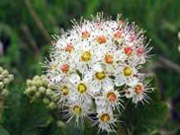
Pacific Ninebark-Physocarpus capitatus
Rapid growing, reaching 8 feet to 15 feet, with a fountain-like form, these relatives of Spirea have similar dense clusters of tiny white flowers in early summer. Foliage is toothed and lobed, like a small maple, a pleasing rose-brown color in the fall. Bark peels or shreds to reveal “nine” layers. Common in moist sites, along streams throughout our area, it is useful as a woodland native. It is great for riparian planting, was one of the very first to regenerate after Wagner Creek suffered a severe flood. But try it also in a mixed shrub border. Give Ninebark moist but well-drained, fertile, acidic soil in full sun or partial shade

Blood Currant-Ribes sanguineum
It is a deciduous shrub growing to 4 m tall. The bark is dark brownish-grey with prominent paler brown lenticels. The leaves are 2-7 cm long and broad, palmately lobed with five lobes; when young in spring, they have a strong resinous scent. The flowers are produced in early spring at the same time as the leaves emerge, on racemes 3-7 cm long of 5-30 flowers; each flower is 5-10 mm diameter, with five red or pink petals. The fruit is dark purple oval berry 1 cm long, edible but with an insipid taste.
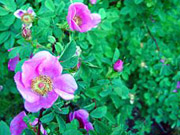
Nootka Rose-Rosa nutkana
The Nootka rose is an attractive shrub to 3 meters high. The stems are usually green, but occasionally may be reddish. The stems grow straight and erect and are not intertwined as with the clustered wild rose. The prickles are curved backward and found in pairs below the stipules or leaf petioles. The prickles of this species are larger and thicker than those of the other native rose species.
The leaves are alternate on the stems and they are pinnately compound with 5-7 leaflets. The leaflets are dark green above and paler and slightly hairy below. The leaflets are elliptic or ovate in shape with serrated or doubly serrate margins, and range from 1-7 cm long and 0.7-4.5 cm wide.
The pink or rose-colored flowers are usually solitary, although 2-3 may be found at the ends of newer, prickliness side branches. The flowers are large sweetly scented, and showy, ranging from 5-8 cm across. Individual petals are 2.5-4 cm long, and 5 petals are the norm for the flowers. The rose hips are spherical, orange-red and large, ranging from 1-2 cm wide. The sepals and dried stamens remain attached to the tips.
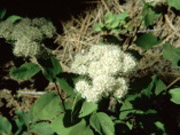
Shiny-leaf Spirea-Spiraea betulifolia var.lucida is an attractive, deciduous shrub with spreading to erect stems from 40-70 cm high. The bark of older stems is reddish. It spreads fairly easily via rhizomes. The leaves alternate on the stems. They are oval-shaped or obovate and 2-7 cm long. They are dark green on the upper surfaces and lighter on the lower surface. The blades are often widest above the middle, and they are irregularly and coarsely-toothed from the tip to the middle of the leaf.
The inflorescence is a flat-topped cluster of white flowers about 3-12 cm across known as a corymb. Although commonly white, the small flowers may also be tinged with pink or purple. The flowers are saucer-shaped and about 5 mm across. Each flower has 5 tiny petals and about 25-50 long stamens. The fruits are beaked, pod-like capsules about 3 mm long.
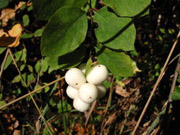
Common Snowberry-Symphoricarpos albus
This plant was once popular in old-fashioned dooryard gardens; variety laevigatus of this shrub is also cultivated. Two other species are often encountered: Coralberry (S. orbiculatus), with sessile, axillary, purplish-green flowers and showy clusters of pink berries; and Wolfberry (S. occidentalis) a dry prairie shrub with pale pink flowers, leathery, oval leaves, and greenish-white fruit. This hollow-stemmed shrub has tiny, pinkish-white, bell-shaped flowers in small terminal or axillary clusters.
Flowers: 1/4″ (6 mm) long; corolla 5-lobed.
Leaves: 1-2″ (2.5-5 cm) long; opposite, oval, dull gray-green.
Fruit: a white, waxy, berry-like drupe, 1/2″ (1.3 cm) wide, persisting into early winter.

Western Meadowrue-Thalictrum occidentale
The meadow rues have long been used ornamentally as decorative plants in the shade garden. My experience has only been with domesticated varieties that have fine, lacy and glaucous foliage but spread their seed so prolifically that they soon take over the garden. I’m not sure how this native species would behave (hopefully it’s more restrained!), but it is smaller in stature where it would blend in better with the chocolate lilies, sour grass, and star-flowered false Solomon’s seal.
That said, western meadow rue is an attractive wildflower with erect, lacy-leafed stems arising 40-100 cm high. The herbage ranges from smooth to somewhat glandular-hairy. The leaves are found mostly on the stems where they are alternately arranged. Individual leaves are 3-4 times ternately divided, the individual leaflets generally triangular or wedge-shaped with the tips 3-lobed.
The inflorescence is leafy and bracteate with small leaves or bracts among the flowers. Petals are lacking but the 4-5 sepals are 2-3 mm long and greenish-white to purplish in color. The 15-30 stamens of male flowers are pendant shaped, the long thin filaments ranging from 4-8 mm long, tipped with purplish anthers. The ovaries are found on female flowers, with the stigmas measuring 3-4.5 mm long and usually of a purplish color. The fruit consist of 7-11 spreading to reflexed achenes
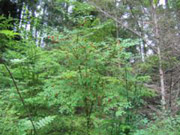
Red Huckleberry –Vaccinium parvifolium Common as individuals along forest-prairies edges. Erect shrub to 4 m tall. Bright green smooth bark. Mostly deciduous (few persistent) oval, non-toothed edge leaves to 3 cm long are similar bright green as bark. Single greenish-yellow to pink, bell-shaped, ~5 mm long flowers occur along branches. Edible, but tart, fruits are 5-10 mm bright red spherical berries that form by mid-summer. Harvested by indigenous peoples by shaking plants and letting berries fall in baskets. Eaten fresh and dried.